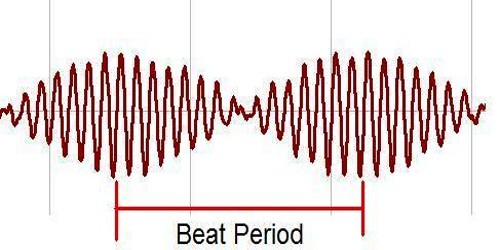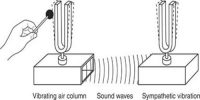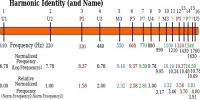Application of Beats
When two sound waves of equal or nearly equal intensity and nearly equal frequencies originate at the same time and travel along the same direction, the loudness of the resulting sound is not uniform; rather it rises and falls at a particular interval of time. These periodic variations of loudness are called beats.
There are three applications of beats, viz –
(a) Determination of unknown frequency of tuning fork.
(b) Determination of poisonous gases in mines.
(c) Determination of the tone of musical instruments.
- Determination of unknown frequency
Applying the phenomenon of beat unknown frequency ‘n’ of a tuning fork can be measured. A tuning fork of known frequency is chosen by trial and error which produces beat with this tuning fork. If the known frequency of the tuning fork is n1, then unknown frequency is almost equal to ‘n’. Now number of beats in is counted. According to definition, m = n1 – n. Then a small amount of wax is attached to any arm of the tuning fork to slightly decrease the frequency in order to find whether n1 is greater or smaller than ‘n’. If number of beats increases then n1 is greater than ‘n’, hence m = n1 – n or, n1 = n + m. But if the number of beats decreases then m = n – n1 or, n, = n – m. In this way, the unknown frequency of the tuning fork can be determined. In Sonometer experiment, beats can be used to adjust the vibrating length between the two bridges. To find the frequency (n) of the given tuning fork beats can be used.
The phenomenon of beats is helpful in tuning two vibrating bodies in harmony For example; a sonometer wire can be tuned in harmony with a tuning fork by observing the beats. When an excited tuning fork is kept on the sonometer and if the sonometer wire is also excited, beats are heard, when the frequencies are almost equivalent.
- Determination of poisonous gases in mines
In order to ascertain the presence of poisonous gas in mine, two identical organ pipes are taken. One pipe is filled with pure dry air and the other pipe with an air of the mine. The pipes are then blown together. If the air of the mine is pure, no beats are heard. If the air of the mine is impure, then there will be a change in frequencies between the sounds of the two pipes and hence beats will be formed. The formation of beats indicates the presence of poisonous gases in mines.
Conclusion: If beats are formed, then it is clear that the air of the mine is impure.
- Determination of the tone of musical instrument
In order to vibrate two musical instruments in the same tone, these instruments are sounded together and the presences of beats are noticed. If the tones are identical then no beats will be heard. In this way tones of different musical instruments can be adjusted and determined by beats. If the length of the wire is adjusted suspiciously so that the number of beats steadily decreases to zero, then the two are said to be in harmony. Most of the musical instruments are made to be in harmony based on this method.















